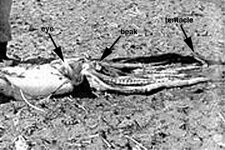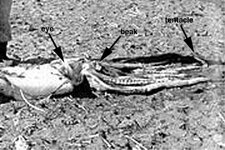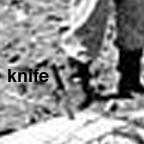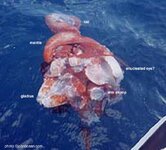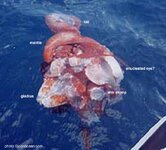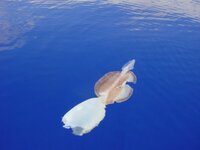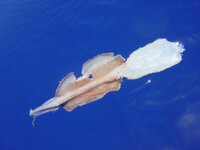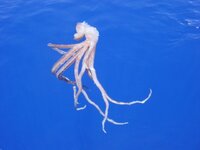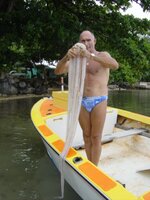- Joined
- Apr 6, 2003
- Messages
- 1,839
As Steve O'Shea has noted in his posts about squid beaks from whale stomachs, it's rare to find an intact giant squid in Physeter's GI tract. I've never seen a photo of such a find, so I was very excited to find the attached image.
Cool Antarctica is a site run by a very sharp fellow named Paul Ward, a marine biologist who did a stint in Antarctica and is now an educator living in England. Paul has made a very fine site, providing an excellent and concise history of whaling operations in Antarctica; his online collection of whaling photographs and ephemera is well worth an extended look. Paul was kind enough to allow me to post the image, and provided the following background information:
The picture was published in Budker 1959 "Whales and Whaling"...The squid in question came from a whale killed off the Azores in July 1955 and according to the book was 34 feet long including tentacles and weighed 405 pounds (which seems a bit heavy to me from the size of it in the picture - though I'm no expert). The book notes that "This is probably the only complete specimen of such an animal to be collected under these conditions", Paul Budker is a well respected scholar, so I'd say his information is probably reliable and accurate.
There is a reference that you will be interested in, which is the source of this information, though I don't know how you could follow it up:
"A giant squid swallowed by a sperm whale" by Robert Clarke. The Norwegian Whaling Gazette, No.10 (1955), pages 589-593.
Robert Clarke has authored or co-authored numerous scientific papers devoted to cetaceans, among them a recent and intriguing sounding work, aquired by NOAA's National Marine Mammal Laboratory, titled "When attacking their prey sperm whales are upside down." (Clarke, Robert and Obla Paliza. 2003. Marine Mammal Science 19(3): 607-608) Does anyone out there have access to these papers?
I've made a few sparsely annotated blow-ups from the photograph. Presumably it's Architeuthis, but there are a few atypical details. The visible remnant of the fins suggest a rather large tail, and the arms appear both shorter and more slight than is the norm for big, mature GS. The eye looks positively enormous.
Also, there's a knife stuck in the squid's mantle.
I owe a big debt of thanks to Paul Ward for posting this image and allowing me to re-post it here, and for providing citations. He's been to TONMO before, and will hopefully check in on this thread. Thanks, Paul!
Clem

